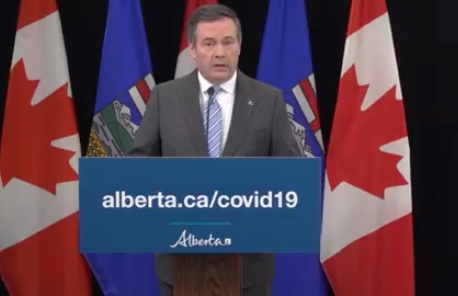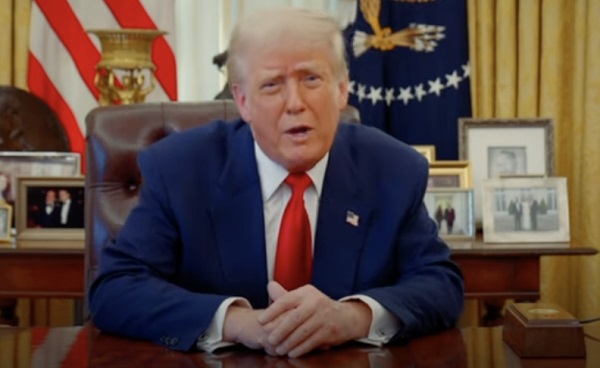Alberta
Alberta ramps up vaccine rollout

Alberta’s government will bring in four new measures starting immediately to ramp-up the COVID-19 vaccine rollout as infections and hospitalizations rise.
The new measures will mean about 500,000 more Albertans will be eligible to be vaccinated starting April 7.
“We are in a race between the vaccines and variants, and finally doses are arriving in significant numbers. We will use these to aggressively expand our rollout, speeding up the timelines and expanding the ways that we get the doses to Albertans. We will meet or surpass our promise to offer every adult a first dose by June 30.”
“Our health officials are working hard to make new shipments of vaccine available to Albertans as soon as they arrive. I strongly urge Albertans to get immunized as soon as they are eligible. When it’s your turn, please sign up for your shot, show up for your appointment and follow up for your second dose.”
Opening bookings to everyone in Phase 2B
Starting April 7 at 8 a.m., anyone born in 2005 or earlier with eligible underlying health conditions can book appointments for the COVID-19 vaccine at participating pharmacies or with Alberta Health Services (AHS) online or by calling 811.
Those currently eligible under Phase 2B are Albertans with underlying health conditions born in or before 1973. This amounts to about 150,000 Albertans. By expanding to those born in 2005 or before, 500,000 more Albertans will be eligible.
Information on eligible health conditions, including examples, is available at alberta.ca/vaccine.
AstraZeneca vaccine available for Albertans 55+
Albertans aged 55 to 64 who do not have a chronic health condition can now make an appointment to receive the AstraZeneca vaccine.
Effective immediately, anyone born between 1957 and 1966 can book appointments at participating pharmacies across the province. AHS will also begin booking appointments starting on Monday, April 12.
The AstraZeneca vaccine is safe and effective at reducing severe illness from COVID-19. The rare blood clots reported in Europe have not been reported in Canada, and risk of COVID-19 infection is far greater than any vaccine risk.
Based on current evidence, Albertans who are 55 and older who are diagnosed with COVID-19 are at least 10 times more likely to be admitted to the intensive care unit from COVID-19, and at least 45 times more likely to need hospital treatment for COVID-19, than they are to experience any form of the rare, treatable blood clots reported in Europe.
Eligible Albertans in this phase can choose to wait to receive a Pfizer or Moderna vaccine to be available to them when Phase 2D opens in May.
Rapid flow clinics
Bookings for rapid flow clinics in Grand Prairie, Fort McMurray, Red Deer, Lethbridge and Medicine Hat will open on Friday, April 9. More clinics will open in Edmonton and Calgary next week.
Bookings can be made with Alberta Health Services (AHS) online or by calling 811.
Pharmacy walk-ins
Alberta will soon expand its vaccine rollout at participating pharmacies to allow walk-in bookings, rather than those by appointment only. Additional information will be shared when pharmacy walk-ins become available next week.
Alberta’s government is responding to the COVID-19 pandemic by protecting lives and livelihoods with precise measures to bend the curve, sustain small businesses and protect Alberta’s health-care system.
Alberta
Is Canada’s Federation Fair?


 David Clinton
David Clinton
Contrasting the principle of equalization with the execution
Quebec – as an example – happens to be sitting on its own significant untapped oil and gas reserves. Those potential opportunities include the Utica Shale formation, the Anticosti Island basin, and the Gaspé Peninsula (along with some offshore potential in the Gulf of St. Lawrence).
So Quebec is effectively being paid billions of dollars a year to not exploit their natural resources. That places their ostensibly principled stand against energy resource exploitation in a very different light.
You’ll need to search long and hard to find a Canadian unwilling to help those less fortunate. And, so long as we identify as members of one nation¹, that feeling stretches from coast to coast.
So the basic principle of Canada’s equalization payments – where poorer provinces receive billions of dollars in special federal payments – is easy to understand. But as you can imagine, it’s not easy to apply the principle in a way that’s fair, and the current methodology has arguably lead to a very strange set of incentives.
According to Department of Finance Canada, eligibility for payments is determined based on your province’s fiscal capacity. Fiscal capacity is a measure of the taxes (income, business, property, and consumption) that a province could raise (based on national average rates) along with revenues from natural resources. The idea, I suppose, is that you’re creating a realistic proxy for a province’s higher personal earnings and consumption and, with greater natural resources revenues, a reduced need to increase income tax rates.
But the devil is in the details, and I think there are some questions worth asking:
- Whichever way you measure fiscal capacity there’ll be both winners and losers, so who gets to decide?
- Should a province that effectively funds more than its “share” get proportionately greater representation for national policy² – or at least not see its policy preferences consistently overruled by its beneficiary provinces?
The problem, of course, is that the decisions that defined equalization were – because of long-standing political conditions – dominated by the region that ended up receiving the most. Had the formula been the best one possible, there would have been little room to complain. But was it?
For example, attaching so much weight to natural resource revenues is just one of many possible approaches – and far from the most obvious. Consider how the profits from natural resources already mostly show up in higher income and corporate tax revenues (including income tax paid by provincial government workers employed by energy-related ministries)?
And who said that such calculations had to be population-based, which clearly benefits Quebec (nine million residents vs around $5 billion in resource income) over Newfoundland (545,000 people vs $1.6 billion) or Alberta (4.2 million people vs $19 billion). While Alberta’s average market income is 20 percent or so higher than Quebec’s, Quebec’s is quite a bit higher than Newfoundland’s. So why should Newfoundland receive only minimal equalization payments?
To illustrate all that, here’s the most recent payment breakdown when measured per-capita:
 |
For clarification, the latest per-capita payments to poorer provinces ranged from $3,936 to PEI, $1,553 to Quebec, and $36 to Ontario. Only Saskatchewan, Alberta, and BC received nothing.
And here’s how the total equalization payments (in millions of dollars) have played out over the past decade:
Is energy wealth the right differentiating factor because it’s there through simple dumb luck, morally compelling the fortunate provinces to share their fortune? That would be a really difficult argument to make. For one thing because Quebec – as an example – happens to be sitting on its own significant untapped oil and gas reserves. Those potential opportunities include the Utica Shale formation, the Anticosti Island basin, and the Gaspé Peninsula (along with some offshore potential in the Gulf of St. Lawrence).
So Quebec is effectively being paid billions of dollars a year to not exploit their natural resources. That places their ostensibly principled stand against energy resource exploitation in a very different light. Perhaps that stand is correct or perhaps it isn’t. But it’s a stand they probably couldn’t have afforded to take had the equalization calculation been different.
Of course, no formula could possibly please everyone, but punishing the losers with ongoing attacks on the very source of their contributions is guaranteed to inspire resentment. And that could lead to very dark places.
Note: I know this post sounds like it came from a grumpy Albertan. But I assure you that I’ve never even visited the province, instead spending most of my life in Ontario.
Which has admittedly been challenging since the former primer minister infamously described us as a post-national state without an identity.
Subscribe to The Audit.
For the full experience, upgrade your subscription.
Alberta
Big win for Alberta and Canada: Statement from Premier Smith

Premier Danielle Smith issued the following statement on the April 2, 2025 U.S. tariff announcement:
“Today was an important win for Canada and Alberta, as it appears the United States has decided to uphold the majority of the free trade agreement (CUSMA) between our two nations. It also appears this will continue to be the case until after the Canadian federal election has concluded and the newly elected Canadian government is able to renegotiate CUSMA with the U.S. administration.
“This is precisely what I have been advocating for from the U.S. administration for months.
“It means that the majority of goods sold into the United States from Canada will have no tariffs applied to them, including zero per cent tariffs on energy, minerals, agricultural products, uranium, seafood, potash and host of other Canadian goods.
“There is still work to be done, of course. Unfortunately, tariffs previously announced by the United States on Canadian automobiles, steel and aluminum have not been removed. The efforts of premiers and the federal government should therefore shift towards removing or significantly reducing these remaining tariffs as we go forward and ensuring affected workers across Canada are generously supported until the situation is resolved.
“I again call on all involved in our national advocacy efforts to focus on diplomacy and persuasion while avoiding unnecessary escalation. Clearly, this strategy has been the most effective to this point.
“As it appears the worst of this tariff dispute is behind us (though there is still work to be done), it is my sincere hope that we, as Canadians, can abandon the disastrous policies that have made Canada vulnerable to and overly dependent on the United States, fast-track national resource corridors, get out of the way of provincial resource development and turn our country into an independent economic juggernaut and energy superpower.”
-

 2025 Federal Election2 days ago
2025 Federal Election2 days agoPoilievre To Create ‘Canada First’ National Energy Corridor
-

 International2 days ago
International2 days agoFREE MARINE LE PEN!’: Trump defends French populist against ‘lawfare’ charges
-

 COVID-191 day ago
COVID-191 day agoMaxime Bernier slams Freedom Convoy leaders’ guilty verdict, calls Canada’s justice system ‘corrupt’
-

 Automotive2 days ago
Automotive2 days agoDark Web Tesla Doxxers Used Widely-Popular Parking App Data To Find Targets, Analysis Shows
-

 Carbon Tax1 day ago
Carbon Tax1 day agoThe book the carbon taxers don’t want you to read
-

 Business2 days ago
Business2 days agoWill Trump’s ‘Liberation Day’ Tariffs End In Disaster Or Prosperity?
-

 Censorship Industrial Complex2 days ago
Censorship Industrial Complex2 days agoChina announces “improvements” to social credit system
-

 International2 days ago
International2 days agoGermany launches first permanent foreign troop deployment since WW2








